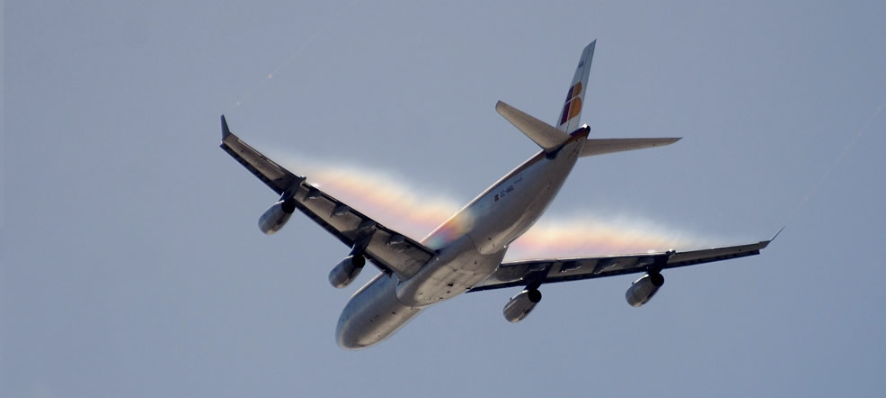Winged Iridescence
Winged Iridescence: A Captivating Phenomenon Explained in Detail
Have you ever marveled at the breathtaking display of iridescent colors shimmering across the wings of an aircraft? This mesmerizing spectacle, known as "Winged Iridescence," occurs when sunlight is diffracted by millions of water droplets condensed by the airflow over the wings. The droplets, having similar life histories and sizes, create the perfect conditions for this captivating optical phenomenon.
Understanding the Occurrence of Condensation
Condensation takes place when the pressure of water vapor in the air surpasses its saturation vapor pressure, rendering it unstable. In the presence of dust particles acting as nuclei, the excess vapor condenses into droplets through a process known as heterogeneous nucleation. However, in the absence of nuclei, condensation becomes more challenging, resulting in supersaturation of the air. Interestingly, when the level of supersaturation exceeds a critical value, water condenses rapidly as a mist of fine droplets, even without the presence of nuclei. This phenomenon is referred to as homogeneous nucleation.
The Role of Airflow and Temperature
The airflow over the top surface of aircraft wings is notably faster than in other areas. As the air flows rapidly, it experiences lower pressure and subsequently expands. This expansion leads to a cooling effect. When the humidity is sufficiently high and the air temperature is relatively warm (as warm air can hold more water vapor than cold air), it creates favorable conditions for heterogeneous or even homogeneous nucleation. In certain instances, the air may already be supersaturated before the aircraft passes through, resulting in trails of condensed droplets from the wings that occasionally exhibit spectacular iridescence.
The Transient Nature of Droplets
While some droplets evaporate quickly, others persist and, when combined with the water generated by combustion in the engines, form what is commonly known as a contrail. These contrails are visible trails of condensed droplets that can linger in the atmosphere for extended periods, contributing to the overall atmospheric optics.
The Complexity of Winged Iridescence
Winged Iridescence is a complex optical phenomenon that arises from the interplay of various factors. Understanding the intricate mechanisms behind this captivating display requires considering the following aspects:
- Humidity and Temperature: High humidity levels and warm air temperatures are crucial for creating the conditions necessary for droplet formation and subsequent iridescence.
- Airflow Patterns: The differential airflow over the wings, particularly on the top surface, plays a significant role in creating areas of lower pressure and cooling, which contribute to droplet formation.
- Supersaturation: Supersaturation occurs when the air contains an excess of water vapor beyond its saturation point. When this exceeds a critical value, rapid condensation occurs, leading to the formation of fine droplets.
- Nucleation: The presence of dust particles or other nuclei facilitates heterogeneous nucleation, allowing for droplet formation. However, homogeneous nucleation can also occur in certain conditions even without the presence of nuclei.
- Sunlight Diffraction: The iridescent colors observed in Winged Iridescence are a result of sunlight being diffracted by the condensed water droplets, causing a stunning display of shifting hues.
Appreciating the Beauty of Atmospheric Optics
Winged Iridescence serves as a captivating reminder of the intricate interplay between light, water, and atmospheric conditions. This phenomenon not only showcases the remarkable beauty found in nature but also highlights the scientific principles governing our everyday experiences. Whether it's gazing at an airplane passing overhead or observing natural atmospheric phenomena, taking a moment to appreciate these awe-inspiring displays can deepen our understanding and appreciation of the world around us.
So, the next time you witness the enchanting iridescence dancing across the wings of an aircraft, remember the delicate balance of factors that contribute to this captivating optical phenomenon. From the airflow patterns to humidity levels and temperature, each element plays a vital role in creating the mesmerizing display known as Winged Iridescence.

Aircraft Condensation Iridescence. Roberto Figueredo Simonetti imaged this Iberia A340 over Montevideo (Uruguay) on its approach to Carrasco International Airport. ©Roberto Figueredo Simonetti, shown with permission.
The iridescent colours are sunlight diffracted by millions of water droplets condensed by the airflow over the wings. The droplets all have similar life histories and therefore similar sizes, ideal conditions for iridescence.
Why does condensation occur? Once the pressure of water vapour in the air exceeds the saturation vapour pressure it is no longer stable. Provided there are dust particles present to act as nuclei, the excess vapour over the saturation pressure condenses into droplets - heterogeneous nucleation. Without any nuclei, condensation is more difficult. Instead the air becomes supersaturated. However, when the supersaturation exceeds a certain critical value water condenses out very rapidly as a mist of fine droplets even though nuclei are absent. This is homogeneous nucleation.

The flow over the top of aircraft wings is faster than elsewhere. The fast flowing air is at a lower pressure and expands. In doing so it cools. If the humidity is high enough and the air temperature also fairly high (warm air can hold more water as vapour than cold air) then conditions might be reached for heterogeneous or even homogeneous nucleation followed by rapid droplet growth. In some cases the air might already be supersaturated before the aircraft passes. The result? We see trails of condensed droplets from the wings and sometimes these iridesce spectacularly.
In the above case the droplets evaporated quickly. Sometimes they persist and, with the water generated by combustion in the engines, form a contrail.
Note: this article has been automatically converted from the old site and may not appear as intended. You can find the original article here.
Reference Atmospheric Optics
If you use any of the definitions, information, or data presented on Atmospheric Optics, please copy the link or reference below to properly credit us as the reference source. Thank you!
-
<a href="https://atoptics.co.uk/blog/winged-iridescence/">Winged Iridescence</a>
-
"Winged Iridescence". Atmospheric Optics. Accessed on December 22, 2024. https://atoptics.co.uk/blog/winged-iridescence/.
-
"Winged Iridescence". Atmospheric Optics, https://atoptics.co.uk/blog/winged-iridescence/. Accessed 22 December, 2024
-
Winged Iridescence. Atmospheric Optics. Retrieved from https://atoptics.co.uk/blog/winged-iridescence/.